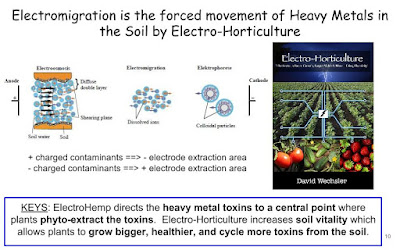Organic Remediation and Toxic Cleanup Its Not Rocket Science - Its Phyto Science. The magic happens in the roots of the plants Naturally with Phytoremediation
Sunday, January 13, 2019
Phytoremediation of heavy metals:
Recent techniques
CONCLUSION
The pollution of soil and water with heavy metals is an environmental concern today. Metals and other inorganic contaminants are among the most prevalent forms of contamination found at waste sites, and their remediation in soils and sediments are among the most technically difficult. The high cost of existing cleanup technologies led to the search for new cleanup strategies that have the potential to be low-cost, low-impact, visually benign, and environmentally sound. Phytoremediation is a new cleanup concept that involves the use of plants to clean or stabilize contaminated environments. Phytoremediation is a potential remediation strategy that can be used to decontaminate soils contaminated with inorganic pollutants. Research related to this relatively new technology needs to be promoted and emphasized and expanded in developing countries since it is low cost. In situ, solar driven technology makes use of vascular plants to accumulate and translocate metals from roots to shoots. Harvesting the plant shoots can permanently remove these contaminants from the soil. Phytoremediation does not have the destructive impact on soil fertility and structure that some more vigorous conventional technologies have such as acid extraction and soil washing. This technology can be applied “in situ” to remediate shallow soil, ground water and surface water bodies. Also, phytoremediation has been perceived to be a more environmentally-friendly “green” and lowtech alternative to more active and intrusive remedial methods.
Chhotu D. Jadia and M. H. Fulekar* Environmental Biotechnology Laboratory, Department of Life Sciences, University of Mumbai, Santacruz (E), Mumbai - 400 098, India. Accepted 19 December, 2008 http://www.ajol.info/index.php/ajb/article/viewFile/59987/48257
Reblogged From: Hazardous Waste Escapes in Flood: The Bridgeton and Westlake Landfills have flooded and the toxins are escaping, a perfect example of places that natural Phytoremediat...
3 Hemp Spokesmen Expose CBD safety
CBD from Hemp with another Phytoremediation Warning.
Hemp is a powerful phytoremediation crop, which means it cleans the soil. Stanley (It's also referred to as a bio-accumulator.)
That means where hemp is planted,
it absorbs everything that's in the soil around it—which can include toxins, heavy metals, pesticides, and nuclear fallout.
You'll want to ensure the hemp in your product is grown using responsible farming practices in soil that is pre-tested for toxins.
Reeves emphasized this too, saying the way hemp is grown is tantamount to its safety as a consumer product.
Melany Dobson, chief administrative officer at Hudson Hemp advises:
Look for CBD products made with American-grown hemp because they're generally safer than hemp grown overseas.Article source How to Buy the Best Safe and Effective CBD Products
Saturday, January 12, 2019
ElectroHemp Remediation Cost Comparison
ElectroHemp cost comparison with traditional remediation technique. 1 city block.
Reference: Findings and Recommendations for the Remediation...
Reference: Findings and Recommendations for the Remediation...
The costs of remediating a site will vary depending on the concentration and distribution of the contamination, the size and layout of the site, and the remedial actions implemented. Table 6 presents cost estimates associated with each remedial option presented above for 1 acre of contamination that is assumed to be 1 foot deep (1 acre foot). These costs are based on the remediation of undeveloped farmland.
Remediation costs could rise dramatically for existing development due to difficulties associated with the movement of soil around existing structures, trees, pools and decks. In addition, the remediation of properties with existing development would not have the benefits of economy of scale associated with undeveloped land. |
https://www.nj.gov/dep/special/hpctf/final/costs.html
|
Proven and innovative soil treatment technologies
$50,000- $100,000 Remedial Option Cost per acre-foot
$50,000- $100,000 Remedial Option Cost per acre-foot
1 acre=1 acre is approximately 208.71 feet × 208.71 feet (a square) = 1 acre = 43,560 square feet X 1 foot soil = 43,560 cu yds soil
- Low: $50,000 ÷ 43,560 = $1.15 /cuyd
- High: $100,000 ÷ 43,560 = $2.30 /cuyd
_____
1 city block Ave size = typical city block as 100,000 sq.ft. 100,000 X 1 foot deep = 100,000 cu yd soil
_____
Saturday, January 5, 2019
Denitrifying Bioreactor
Dentrifying Bioreactors information, designs, tips, best use and information.
What is a woodchip bioreactor?
 |
| Purdue University |
Bioreactors are essentially subsurface trenches filled with a carbon source, mainly wood chips, through which water is allowed to flow just before leaving the drain to enter a surface water body. The carbon source in the trench serves as a substrate for bacteria that break down the nitrate through denitrification or other biochemical processes. Bioreactors provide many advantages:
- They use proven technology
- They require no modification of current practices
- No land needs to be taken out of production
- There is no decrease in drainage effectiveness
- They require little or no maintenance
- They last for up to 20 years.
How do bioreactors work? Organisms from the soil colonize the woodchips. Some of them break down the woodchips into smaller organic particles. Others “eat” the carbon produced by the woodchips, and “breathe” the nitrate from the water. Just as humans breathe in oxygen and breathe out carbon dioxide, these microorganisms breathe in nitrate and breathe out nitrogen gas, which exits the bioreactor into the atmosphere. Through this mechanism, nitrate is removed from the tile water before it can enter surface waters.
Understanding Woodchip Bioreactors
Designing and Constructing Bioreactors to Reduce Nitrate Loss from Subsurface Drains (Illinois, tri-fold format)
Woodchip Bioreactors for Nitrate in Agricultural Drainage (Iowa, 4 pages. Click "Download" in blue table.)
"Evaluating Denitrifying Bioreactors" - On the Ground with the Leopold Center (Video from Iowa, 2:35)
Bioreactors: Benefits and Potential Challenges" - Iowa Learning Farms Webinar (Video recording from Iowa)
Design Information
Denitrifying Bioreactor (Code 747)NRCS Interim Conservation Practice Standard in Iowa and Indiana. Iowa Statement of Work
Interactive routine that can be used to determine size, cost and evaluate performance of a bioreactor installed in a field with a specified soil and county in Illinois:
http://www.wq.illinois.edu/dg/Equations/Bioreactor.exe.
Financial Incentives
Denitrifying Bioreactors are eligible for financial assistance through the NRCS Environmental Quality Incentives Program, Where the conservation practice standard has been accepted, financial assistance is often available through EQIP. In Indiana, the incentive is $5800. Incentives in Iowa
____
Wednesday, January 2, 2019
2019 R&D ElectroHemp
ElectroHemp is preparing for R&D Projects that will highlight how their system speeds up contamination removal and organically disposes hazardous waste.
- Phytoremediation Assisted Contamination Cleanup
- Organic Hazardous Waste Disposal
- Turning Hazardous Waste into income
- Soil and Water Buffer Zones
- Phytoremediation Rafts for water cleanup and remediation
If you or your organization would like to join in, partner, sponsor, advertise, or just learn more about the R&D projects use the contact form, subscribe to the blog feed or stay tuned by monitoring the blog.
Tuesday, January 1, 2019
Remediation Terminology Definitions
Frequently used Soil and Water definitions ElectroHemp uses when sharing the BioRad system and process which organically cleans Water and Soil in the Phyto-Enhanced system.
 |
| Phytoremediation is defined by UNEP as the living green plants for in sutu removal, degradtion, and containment in soils, surface waters, and groundwater. |
 |
| Bioremediation is a process that uses mainly microorganisms, plants, or microbial or plant enzymes to detoxify contaminates in the soil and other environments. |
 |
| Heavy Metals are defined as the metals that have an atomic mass greater than 20 and are transition metals, metalloids, actinides, and lanthanides. |
 |
| Toxicity is the ability of a substance to cause a living organism to undergo adverse effects upon exposure. |
Monday, December 31, 2018
ElectroHemp 2019 Plans
2019 is the year ElectroHemp takes Phytoremediation Assisted Science to the Field in Pilot Study activities.
The Future Phytoremediation Assisted Soil and Water Cleanup Pilot Study Activity will include:
ElectroHemp Pilot Study's will be undertaken to perfect and streamline the organic green remediation system and process of the Team has been fine-tuning.
ElectroHemp Job Opportunity Examples: 9 or More job slots with possible Dual and Tri job responsibilities.
The Future Phytoremediation Assisted Soil and Water Cleanup Pilot Study Activity will include:
- Business Partnerships
- Job openings
- Science and Scientific collaboration
 |
| ElectroHemp Green Remediation Intro |
ElectroHemp Job Opportunity Examples: 9 or More job slots with possible Dual and Tri job responsibilities.
- Volunteers
- College Internships
- Hazmat Equipment Operator / Driver
- Greenhouse / Horticulturalists
- Environmental Scientist Laboratory & Testing Technician
- Mechanical + Equipment Mechanic
- Electronics Equipment Installation + maintenance
- Records and Bookkeeper
- Attorney Environmental + Patents
- Spokesmen - Advertising
- Marketing - Sales - Contracts
If you are interested in joining the ElectroHemp team or have a property in the St.Louis Region you need assistance with we are interested in working with you.
 |
| ElectroHemp cleans soil and water with a Phytoremediation assisted process that turns pollution into cash. |
Subscribe to:
Posts (Atom)
Search This Blog
ElectroHemp Introduction
ElectroHemp Hazardous Waste Remediation Intro
ElectroHemp BioRad Hazardous Waste Cleanup Introduction ElectroHemp - BioRad CleanUp 5 Stage Phytoremediation Treatment Train - Remove...

-
while reading this I realized the EPA are addressing the spread of the toxins but not the cause of the toxins. tsk tsk tsk @EPA Are you s...
-
ElectroHemp BioRad Hazardous Waste Cleanup Introduction ElectroHemp - BioRad CleanUp 5 Stage Phytoremediation Treatment Train - Remove...
-
If only more business cared about the environment as much as IKEA does. Most everyone has heard that the St Louis IKEA Store is powered ...





















